Range Rover Evoque: Back Panel
Removal
NOTES:
The back panel is manufactured from mild steel, it includes the bumper retaining bracket.
It is necessary to remove a section of both rear lamp mounting panels to enable removal and installation of the back panel.
1. The back panel is replaced in conjunction with:
- Rear bumper cover
- Rear bumper
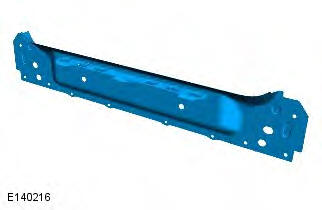
2. For additional information relating to this repair procedure please see the following: For additional information, refer to: Health and Safety Precautions (100-00 General Information, Description and Operation) / Body Repairs (501-25A Body Repairs - General Information, Description and Operation) / Corrosion Protection (501-25B Body Repairs - Corrosion Protection, Description and Operation) / Body and Frame (501-26 Body Repairs - Vehicle Specific Information and Tolerance Checks, Description and Operation) / Standard Workshop Practices (100-00 General Information, Description and Operation).
3. Remove the rear bumper.
For additional information, refer to: Rear Bumper (501-19 Bumpers, Removal and Installation).
4. NOTE: The exhaust system must be supported. Release the exhaust assembly from its mountings.
5. Remove the exhaust silencer heatshield.
6. Remove the rear towing bracket.
7. Remove the RH and LH liftgate bump stop supports.
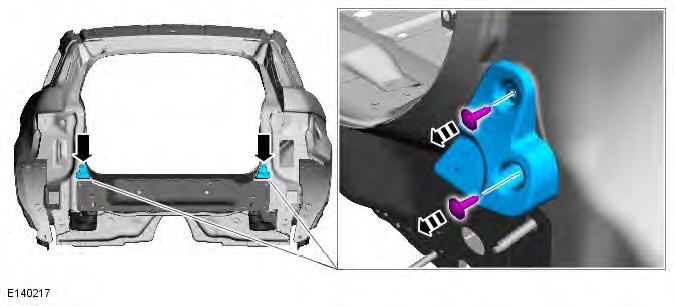
8. Remove the liftgate aperture weatherseal.
9. Remove the RH and LH load space inner trims.
For additional information, refer to: Loadspace Trim Panel (501-05 Interior Trim and Ornamentation, Removal and Installation).
10. LH only. Release and lay aside the keyless vehicle module mounting bracket.
11. Remove the RH and LH forced air extraction grilles.
12. Remove the RH and LH bumper cover upper guides.
13. Release and lay aside the insulating material.
14. Release and lay aside the wiring harnesses.
15.
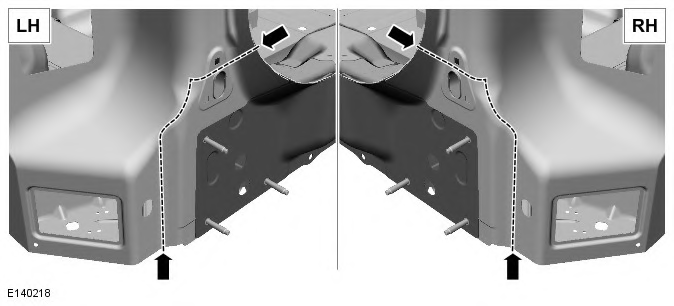
16. Drill out spot welds, for the lamp mounting panel sections.
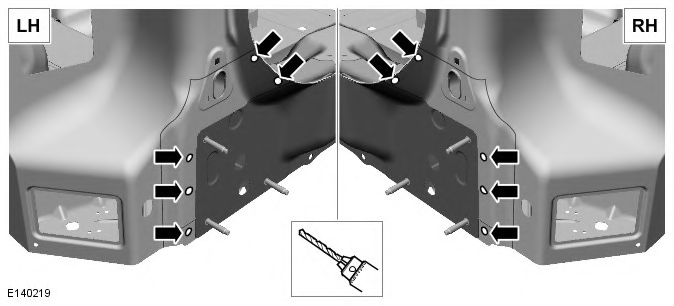
17. NOTE: Retain both rear lamp mounting panel sections for reinstallation. Separate the joints and remove the rear lamp mounting panel sections.
18. Drill out the spot welds.
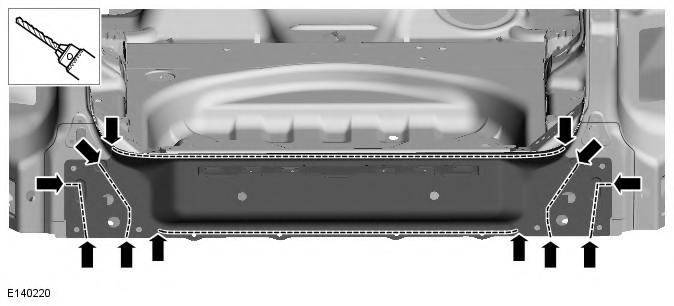
19. Separate the joints and remove the old panel.
Installation
1. Drill holes in the rear lamp mounting panel sections as indicated.
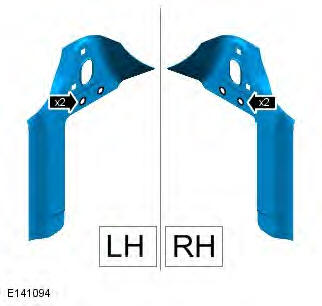
2. Prepare the old and new panel joint surfaces, including the rear lamp mounting panel sections.
3. NOTE: With panel in position check for access to spot weld the joints. Offer up the new panel and clamp into position. Check alignment, if correct, proceed to next step, if not, rectify and recheck before proceeding.
4. Remove the new panel.
5. NOTE: If access is available you can spot weld these joints. Drill holes in the new panel ready for MIG plug welding as indicated.
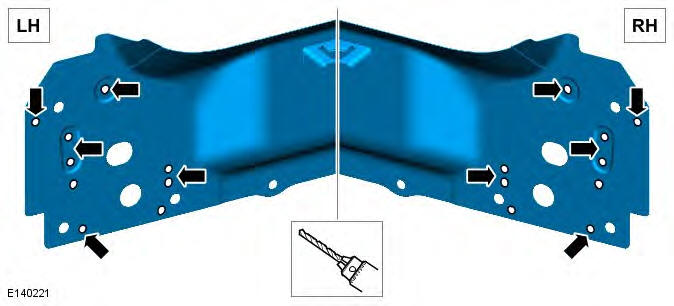
6. Deburr MIG plug locations in new panel.
7. Offer up the new panel and clamp into position. Check alignment, if correct, proceed to next step, if not, rectify and recheck before proceeding.
8. Spot weld.
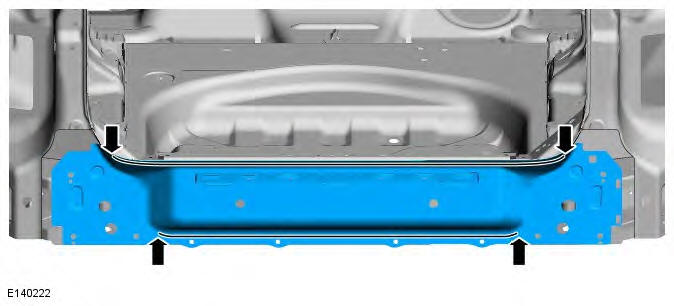
9. MIG plug weld.
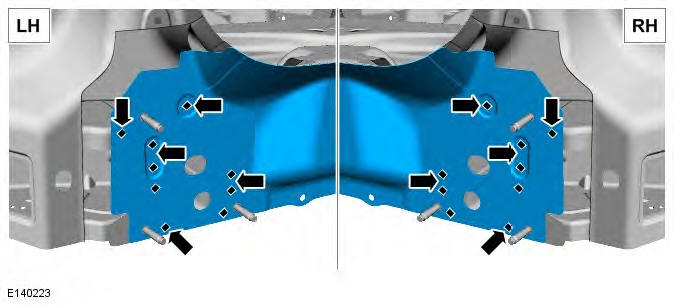
10. NOTE: Some MIG plug welds may interfere with the installation of the rear lamp mounting panel sections. Dress all MIG plug welds.
11. Offer up the rear lamp mounting panel sections and clamp into position. Check alignment, if correct, proceed to next step, if not, rectify and recheck before proceeding.
12. NOTE: Using the removed spot weld hole as a template drill MIG plug location through new panel taking care not to drill into the inner back panel assembly.
While the rear lamp mounting panel sections are clamped in position drill out MIG plug locations as indicated.
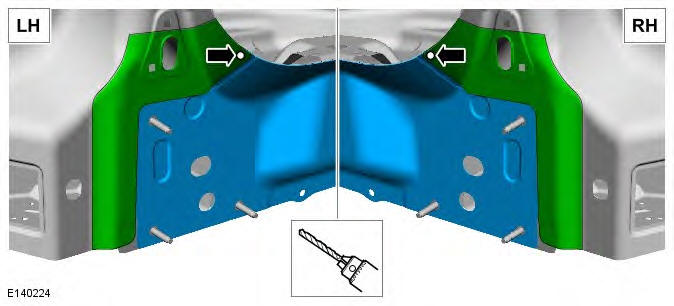
13. Deburr MIG plug locations in new panel.
14. Tack weld the butt joints on rear lamp mounting panel sections.
15. MIG plug weld.
16. Dress the tack welds.
17. MIG weld the butt joints on the rear lamp mounting panel sections.
18. Dress all welded joints.
19. NOTE: Make sure all underbody joints are sealed following this repair procedure. The installation of associated panels and mechanical components is the reverse of removal.
Rear Crossmember
Removal
NOTES:
The rear crossmember is manufactured from mild steel The panel is serviced less its weld studs.
1. The rear crossmember is replaced in conjunction with:
- Rear bumper cover
- Rear bumper
- Back panel
- Inner back panel assembly
- Spare wheel well
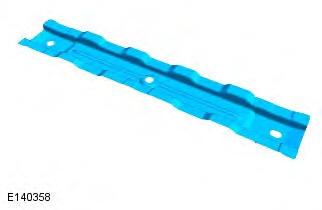
2. For additional information relating to this repair procedure please see the following: For additional information, refer to: Health and Safety Precautions (100-00 General Information, Description and Operation) / Body Repairs (501-25A Body Repairs - General Information, Description and Operation) / Corrosion Protection (501-25B Body Repairs - Corrosion Protection, Description and Operation) / Body and Frame (501-26 Body Repairs - Vehicle Specific Information and Tolerance Checks, Description and Operation) / Standard Workshop Practices (100-00 General Information, Description and Operation).
3. Remove the spare wheel well.
For additional information, refer to: Spare Wheel Well (501-30A Rear End Sheet Metal Repairs - 3-Door, Removal and Installation).
4. Drill out the spot welds as indicated.
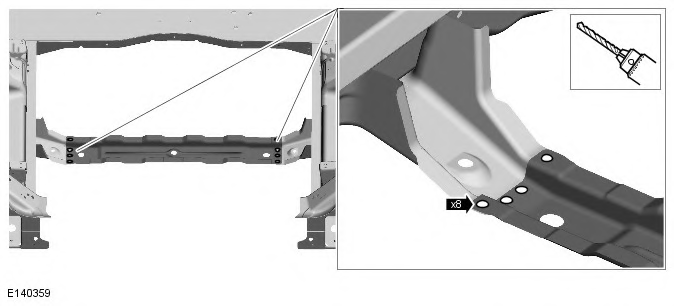
5. Separate the joints and remove the old panel.
Installation
1. Prepare the old and new panel joint surfaces.
2. Offer up the new panel and clamp into position. Check alignment, if correct, proceed to next step, if not, rectify and recheck before proceeding.
3. Spot weld.
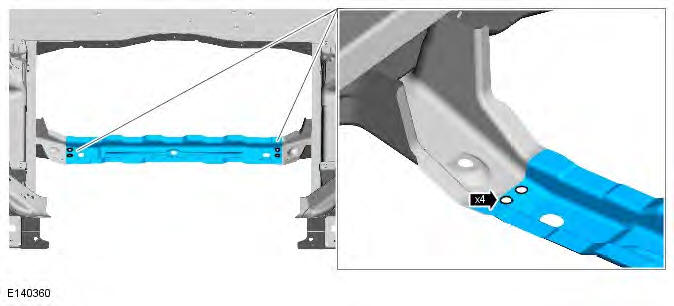
4. Prepare the new panel and install the weld studs in their original locations from underneath.
The measurements provided in the graphic are to be used as a guide only, the components that are located/fixed to these weld studs must be offered up and cross checked for alignment prior to the installation of the weld studs to the new panel.
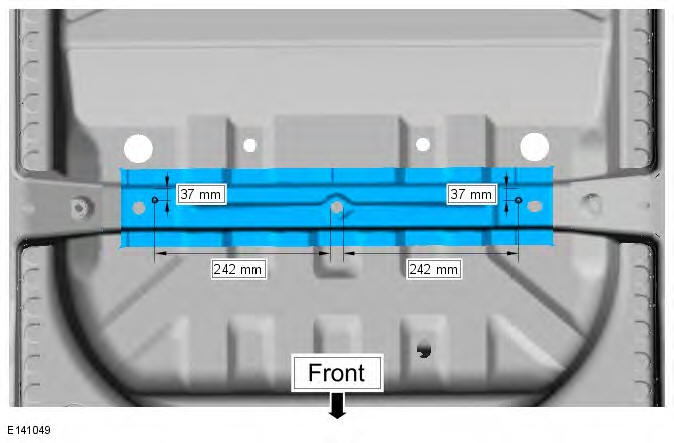
5. Apply a zinc rich primer to any bare metal surfaces at this stage.
6. The installation of associated panels and mechanical components is the reverse of removal.

